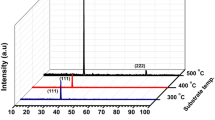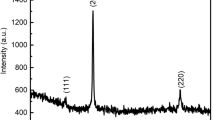Abstract
In the present work, high quality nanostructured thin films of titanium nitride with nanoscale grain sizes have been prepared by the reactive magnetron sputtering method examining the effects of the substrate temperature on the topography, optical and semiconductor properties of the thin films Concretely, the three dimension surface topography of samples was investigated by atomic force microscopy determining the power spectral density functions. Also, a new revised version of the Tauc’s method (named ineffective thickness method) has been proposed for the determination of the optical band gap in nanostructure semiconductor thin films. These studies indicated that the increment of the substrate temperature improves the physical properties of the films modifying the grain size and grain aggregation, and altering the optical band gap of the samples from 4.06 to 3.43 eV. In addition, a competitive growth of crystalline planes with different orientations was found as a result of the occurrence of higher grain sizes in the nanostructured titanium nitride thin films.







Similar content being viewed by others
References
G.L. Zhao, T.B. Zhang, T. Zhang, J.X. Wang, G.H. Han, J. Non-Cryst. Solids 354, 1272–1275 (2008)
G.V. Naik, J.L. Schroeder, X. Ni, A.V. Kildishev, T.D. Sands, A. Boltasseva, Opt. Express 2, 478–489 (2012)
E. Zalnezhad, A.A.D. Sarhan, M. Hamdi, Int. J. Adv. Manuf. Technol. 64, 281–290 (2013)
Y. Matsumura, T. Chujo, H. Uchida, H.H. Uchida, Surf. Coat. Technol. 60, 489–492 (1993)
D. Starosvetsky, I. Gotman, Biomaterials 22, 1853 (2001)
S.H. Ahn, J.G. Kim, J.G. Han, Thin Solid Films 515, 6878 (2007)
S.G. Wang, X.D. Bai, B.C. Wang, Y.D. Fan, Thin Solid Films 278, 67 (1996)
P. Chen, W.Y. Wu, Surf. Coat. Technol. 231, 140–143 (2013)
M. Molamohammadi, A. Arman, A. Achour et al., J. Mater. Sci. Mater. Electron. 26(8), 5964–5969 (2015)
M. Molamohammadi, C. Luna, A. Arman et al., J. Mater. Sci. Mater. Electron. 26(9), 6814–6818 (2015)
T. Ghodselahi, A. Arman, J. Mater. Sci. Mater. Electron. 26(6), 4193–4197 (2015)
Ş. Ţălu, S. Stach, V. Sueiras, N.M. Ziebarth, Ann. Biomed. Eng. 43(4), 906–916 (2015)
S. Kulesza, M. Bramowicz, Appl. Surf. Sci. 293, 196–201 (2014)
A. Arman, T. Ghodselahi, M. Molamohammadi et al., Prot. Met. Phys. Chem. Surf. 51(4), 575–578 (2015)
D. Elenkova, J. Zaharieva, M. Getsova, I. Manolov, M. Milanova, S. Stach, Ş. Ţălu, Int. J. Polym Anal. Charact. 20(1), 42–56 (2015)
J.E. Sundgren, Thin Solid Films 128, 21 (1985)
V. Chawla, R. Jayaganthan, R. Chandra, Mater. Charact. 59, 1015–1020 (2008)
J. Ferre-Borrull, A. Duparre, E. Quesnel, Appl. Opt. 40(13), 2190–2199 (2001)
A. Arman, S. Talu, C. Luna, J. Mater. Sci. Mater. Electron. (2015). doi:10.1007/s10854-015-3628-5
J. Tauc, A. Menth, J. Non-Cryst. Solids 569, 8–10 (1972)
A. Gelali, A. Ahmadpourian, R. Bavadi, M.R. Hantehzadeh, A. Ahmadpourian, J. Fusion Energy 31(6), 586–590 (2012)
Gwyddion 2.37 software (Copyright © 2004–2007, 2009–2014 Petr Klapetek, David Nečas, Christopher Anderson). Available from: http://gwyddion.net. Accessed 27 May 2015
Author information
Authors and Affiliations
Corresponding author
Appendix
Appendix
The basic properties of the height values distribution, including its variance, skewness, kurtosis and PSD were computed according to Ref. [22]. Root-mean-square deviation (S q ), skewness of topography height distribution (S sk ), kurtosis of topography height distribution (S ku ) are parameters that depend on the height deviation, and they are useful for description of amplitude-related properties of a surface. These parameters are applied to describe dispersion, asymmetry of the height distribution and sharpness of the height distribution.
Sq, is a dispersion parameter defined as the root mean square value of the surface departures within the sampling area and is a very general and widely used parameter.
Ssk is the measurement of asymmetry of surface deviations about the mean reference plane and can effectively be used to describe the shape of the topography height distribution.
SKu, is a measure of the peakedness or sharpness of the surface height distribution and characterizes the spread of the height distribution.
Rights and permissions
About this article
Cite this article
Ghobadi, N., Ganji, M., Luna, C. et al. Effects of substrate temperature on the properties of sputtered TiN thin films. J Mater Sci: Mater Electron 27, 2800–2808 (2016). https://doi.org/10.1007/s10854-015-4093-x
Received:
Accepted:
Published:
Issue Date:
DOI: https://doi.org/10.1007/s10854-015-4093-x




